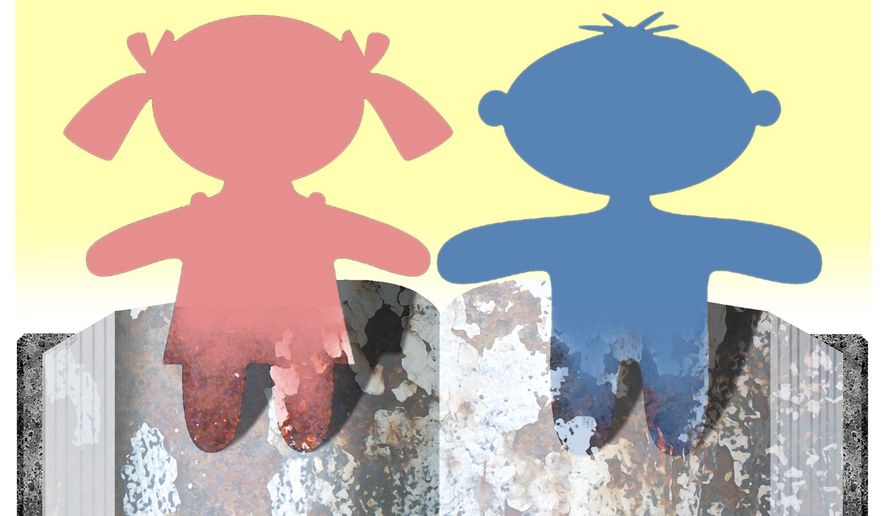OPINION:
I was saddened last month upon hearing of the death of Norton Juster, most famous for his superb children’s book “The Phantom Tollbooth.”
Illustrated by Juster’s friend, Jules Feiffer, the book takes a boy, Milo, through a fantastic journey in his miniature car into the Kingdom of Wisdom, divided into Dictionopolis, where words are supreme, and Digitopolis, where numbers rule.
Published in 1961, “Phantom” is whimsical, fast moving and, as far as I know, non-ideological. Perhaps the “woke” censors won’t get around to finding something fatally wrong with it as they’ve done with Dr. Seuss, Laura Ingalls Wilder and a growing list of Disney fare.
While some recent books for children are clever and uplifting, too many are being written by ideologues with an ax to grind. This is deadly serious, as is the “woke” BLM curriculum being forced on children in government schools. As Vladimir Lenin reportedly said, “Give me your four-year-olds, and in a generation I will build a socialist state.”
Would Norton Juster have gotten his masterpiece published today by a major house without being forced to sully it with PC references? Probably not.
How would you like your toddler to be told that she’s growing up in a hate-filled nation full of White supremacists? If that’s your thing, you can read her “Not My Idea: A Book About Whiteness,” by Anastasia Higginbotham. It’s part of the Black Lives Matter–Kids! List. In the 64-page picture book, children are told to “seek out and listen to the truth about racism and white supremacy, and prepare to be changed, heartbroken, and liberated by this experience.”
If your child is White, she needs to repent and confess her guilt. Or she can be treated to one of several new transgender books and choose to be a boy. Whatever. As for White boys, well, they’re beyond redemption unless they confess hourly or, better yet, want to become girls.
Meghan Cox Gurdon, who writes weekly in The Wall Street Journal about children’s books, recently reviewed a handful of new books that should give any sensible parent nightmares.
Macmillan introduces small children to “Chakras,” “Crystals,” “Meditation” and “Astrology” in a four-volume “Mind Body Baby” series.
Little Simon’s “Pride 123” by Michael Joosten and illustrated by Wednesday Holmes “contains lines such as ‘4 activists fighting the good fight’ and ‘7 divas strike a fierce pose.’”
Chronicle’s 12-volume “Little Zodiac” series of board books by Daria Harper with Anna Hurley’s pictures are pitched for the 3-and-under crowd. “Baby Taurus” includes this line: “With the bright planet Venus ruling your chart, you have a great love for beauty and art.”
The Journal’s Ms. Gurdon asks, “Now, what on sweet Venus is a toddler who’s still in diapers to make of the idea of a planet ruling his chart? Adults can parse this stuff — and buy it, which is the point — but in the context of what makes sense to little children, it’s gibberish.”
Kokila features “Antiracist Baby” with Ashley Lukashevsky’s cartoon pictures, and Marxist Black supremacist Ibram Kendi lecturing pre-verbal children.
“Confess when being racist,” Mr. Kendi advises.
A cartoon baby is shown teetering before getting upright. “Nothing disrupts racism more than when we confess the racist ideas that we sometimes express,” Mr. Kendi says.
An exasperated Ms. Gurdon concludes, “There is perhaps no clearer sign of 2020’s ghastliness than that this dreary work of propaganda has been a bestseller.”
The propaganda is particularly plentiful in the realm of LGBTQ materials, which steer children away from normal sexuality. Elementary-age titles include “King & King,” “Morris Micklewhite and the Tangerine Dress” and “Queer Heroes.”
Fortunately, a high-quality children’s series has been published as a kind of vaccine against this kind of manipulation. Christian author Denise Shick, founder of Help4Families.org, has written four age-appropriate soft-cover books dealing with gender dilemmas.
In “I’m Glad God Made Me a Girl,” illustrated by Yana Popova, sensitive parents gently guide their confused daughter and her masculine-inclined girlfriend toward being comfortable with their own biological reality.
Similarly, in “The Boy Who Liked Tea Parties,” Ms. Shick shows how an engaged, supportive father makes a huge difference in elevating a boy’s self-esteem.
Drawing from her own painful experience of seeing her father identify as a woman, Ms. Shick’s “When Daddy Leaves to Be a Girl” teaches kids not to blame themselves for their parents’ problems.
Finally, in “What’s Up with Cousin Stacy?” parents deal with their child’s reaction to the “coming out” of an older relative and how they can love her while confirming God’s design for human sexuality.
These books aren’t for all children, who deserve to have their innocence protected against our ever-more perverse culture. But they are wonderful aids to help children threatened by sexual dynamics beyond their control.
For all children, there are still classics like “Dr. Seuss’s Sleep Book” and “Green Eggs and Ham,” “Curious George, “A Bear Called Paddington,” “Amelia Bedelia,” “Blueberries for Sal,” “Goodnight Moon,” “Clifford,” “Smokey,” “Go Dog Go” and “Are You My Mother?” There are also many kid-friendly, illustrated Bible stories.
More recent books include “The Circus Ship” by Chris Van Dusen (in fact, all of Mr. Van Dusen’s books), “Goodnight, Goodnight Construction Site,” “A Piglet Named Mercy,” “Little Blue Truck” and the “Bizzy Bear” series. Just scratching the surface here.
When I was in college, my Marxist economics professor actually began the semester by reading us “The Little Red Hen.” He closed the picture book with disgust, proclaiming that it was rife with “Victorian economics” and “capitalist sentiment.”
Which is why it’s a timeless classic.
• Robert Knight is a contributor to The Washington Times. His website is roberthknight.com.




Please read our comment policy before commenting.